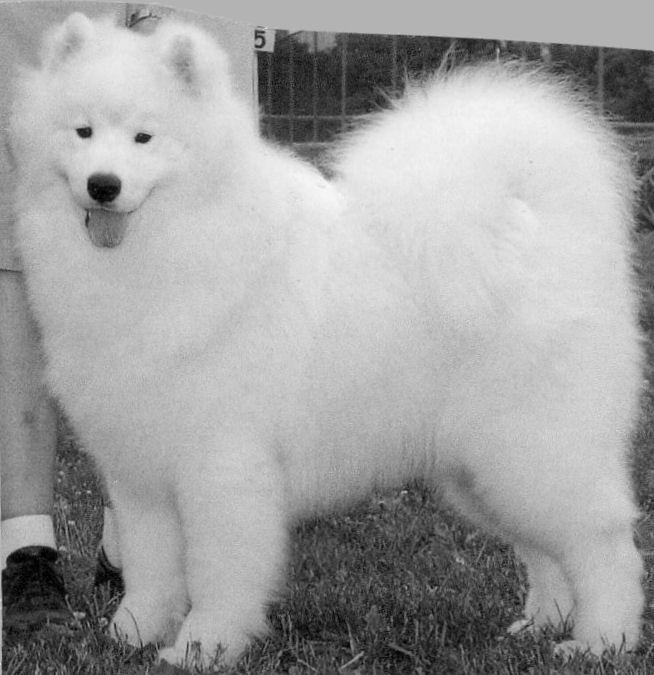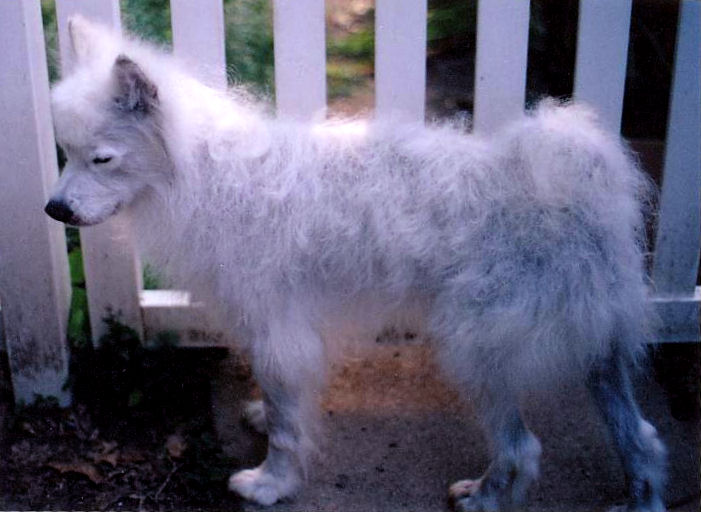Disclaimer:
Information presented in the "Living With..." sections of the SCARF website represent the personal viewpoint of the individual who made the journal entry and do not represent the opinions, positions, or viewpoints of SCARF or the veterinary community. [see complete disclaimer at bottom of page]
- Age at onset: about 12 months
- Sex: Male
- Early signs and symptoms: Continuous hair loss with spotty regrowth
- How the diagnosis was made?: Skin punch biopsy and dermatology consult
My Samoyed had just finished his championship when he was diagnosed with Sebaceous Adenitis (SA), a heartbreaking and dreadful disease. He was only a year old and the Dermatologist said he had a severe case.

I was shocked to discover that Samoyeds ranked behind Poodles and Akitas in the incidence of SA and may rank higher as it is often misdiagnosed.
We decided to treat with a cyclosporine (Atopica) and with weekly oil baths of propylene glycol oil followed by Sebalyt shampoo. This type of oil must remain on the skin for 8 hours, so the recommendation was to do it at night, crate my Samoyed, and bathe him in the morning. The oil is expensive and can only be found in pharmacies that compound medicine, the big chains don't carry it. The oil rinses out easily with tepid water. I have tried other oils, but don't like them nearly as well nor do I think they do as good a job on the skin.
The Dermatologist was not sure how much hair would regrow, but thought we would have a good idea in about 18 months.

After 24 months, there wasn't any significant hair regrowth, so he was taken off the cyclosporine. The oil baths continued and will continue for the rest of his life.
With SA, it is important to realize that each dog's case is different. Each dog's case presents differently, therefore, without a skin punch biopsy, misdiagnoses may occur. SA also waxes and wanes, and what works for one dog may not work for another.
SA is presumed to be inherited, but no one is sure what causes it to become active. It normally rears its ugly head when a dog is older, but that was not the case with my dog. At one point, he was also refusing most foods and dropped half of his body weight.
To be honest, I did consider putting him to sleep. If your dog has been newly diagnosed, I recommend taking a deep breath and not making any hasty decisions. It is still the same dog who loves you unconditionally and deserves the same in return.
My Samoyed is now 4 years old and is doing well, but had had a few setbacks. His treatment currently consist of the weekly oil baths, a fish based diet, fish oil pills twice daily and twice month acupuncture treatment which I believe have helped immensely. He also continues to visit the Dermatologist quarterly.
It is possible to live with a dog with SA. You will shed an ocean of tears, your Samoyed will no longer be beautiful on the outside and people may make cruel, unthinking remarks upon seeing him. On the other hand, you and your dog share a special bond. You will never regret the extra care, time and effort, and yes money spent on his care.
Remember, you are not alone and others will reach out to help you if asked.
February, 2009 update - The most recent addition to his treatment regimen is that one to two days after his bath, I am applying two pipettes of Douxo Seborrhea Spot-On. We are now using Douxo shampoo. If this combination works, there is a chance we may be able to stop the oil treatments. I'm keeping my fingers crossed and will keep you posted.
Disclaimer:
Information presented in the "Living With..." sections of the SCARF website represent the personal viewpoint of the individual who made the journal entry and do not represent the opinions, positions, or viewpoints of SCARF or the veterinary community. There may be discussions of drugs, devices, additives, foods, vitamins, herbs or biologicals that have not been approved by the FDA/CVM for the particular use being discussed. SCARF assumes no liability for the accuracy or outcomes of any suggestions, advice or other information provided by the "Living With..." postings on the SCARF website. All treatment decisions should only be made after discussion with your pet's veterinary health professional, and no changes in your pet's treatments or diet should be made based on any information found on the SCARF website.